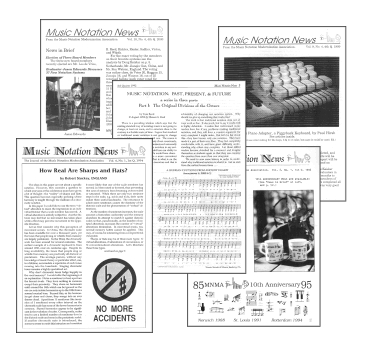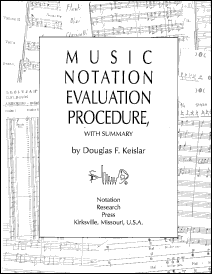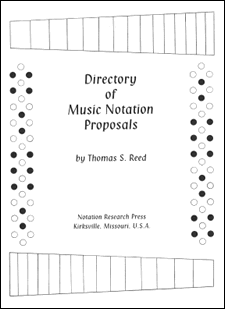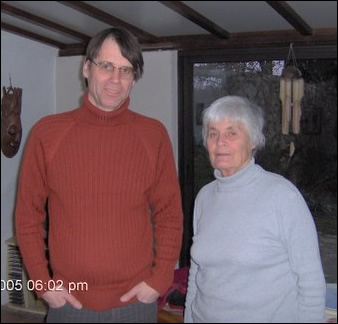- Music Notation News
- Music Notation Evaluation Procedure
- Directory of Music Notation Proposals
- Test for New Notation Systems
- MNMA Website News Archive
Music Notation News — The Quarterly Journal of the MNMA
 Edited by Thomas S. Reed
Edited by Thomas S. Reed
In publication from 1986-2004, Music Notation News was professionally typeset with lots of pictures and notation examples. While it was being published, members of the MNMA received a free subscription. Each issue contained fascinating research and developments in the following areas:
- News about printed music, sheet music, and music publishing
- Proposals for improving the system of music notation
- New instruments and keyboard layouts
- New and alternative notation systems and tablatures
- Experimental and microtonal music
- New methods for teaching music notation
- Book reviews
- Heated debates
8.5 x 11 inches, the number of pages varies from issue to issue. No advertising. ISSN: 0258-963X
$5.00 an Issue (+ Shipping)
Place an Order
Music Notation Evaluation Procedure
 by Douglas F. Keislar
by Douglas F. Keislar
Notation Research Press, 1994
How can one evaluate the many new proposals for improving traditional music notation? This book provides a means that is considered to be fair, thorough, and flexible. The work is the full report of the first (1993-1994) MNMA Evaluation Committee, chaired by Doug Keislar. In addition to the evaluation procedure, the book provides a probing discussion of what music notation is and isn’t, and how music notation should function for a human reader and writer. Recommended for all who are concerned with the written form of music.
90 pages + 18 page summary, paperback. ISBN: 0-9638849-1-3, LC: 94-69390
$25.00 (+ Shipping)
Place an Order
Table of Contents
- Preface
- Overview
- CHAPTER 1 Evaluation Technique
- Goals of the recommended evaluation technique
- Summary of technique
- Phase One: Preparation
- Phase Two: Analysis and Classification
- Phase Three: Evaluation
- Phase Four: Inventing new notation systems
- Phase Five: Scientific testing (optional)
- CHAPTER 2 Definitions
- What is music?
- What is a music notation?
- What is a general-purpose music notation?
- CHAPTER 3 Parameters
- Range and resolution of sound parameters
- Correlation of sound parameters with graphical parameters
- Traditional musical parameters
- A framework for classifying the notation of a parameter
- CHAPTER 4 Time
- Range and Resolution
- Dimensionality
- Quantization
- Tempo
- Transformations
- Parameterization of events
- Time symbols
- CHAPTER 5 Pitch
- Range and Resolution
- Dimensionality
- Quantization
- Transformations
- Pitch symbols
- CHAPTER 6 Other Elements
- Other Parameters
- Non-parametric symbols
- CHAPTER 7 Symbols
- Check for a pre-existing evaluation
- Interactions with other features
- Frequency of use
- Visual clarity
- Precision
- Intuitiveness
- Ease of writing
- Advantages and disadvantages of this symbol
- Other considerations
- CHAPTER 8 Systems
- Evaluation of components of the system
- General-purpose
- Efficiency
- Precision
- Visual clarity
- Intuitiveness
- Ease of writing
- Consistency
- Thoroughness
- Aesthetics
- Advantages and disadvantages of this system
- Other considerations
- CHAPTER 9 Scientific Experiments
- Learning
- Performance tasks
- Multiple-choice tasks
- Threshold of perceptibility
- CHAPTER 10 Suggested Features
- General
- Time
- Pitch
- SUMMARY
Directory of Music Notation Proposals
 by Thomas S. Reed
by Thomas S. Reed
Notation Research Press, 1997
Contains more than 500 proposals for improving on traditional notation, in one way or another. Includes illustrations of 36 alternative notation systems.
212 pages, including the appendix. 8.5 x 11 paperback, with comb binding. ISBN: 0-9638849-2-1, LC: 96-93025
$28.00 (+ Shipping)
Place an Order
Table of Contents
- Ch 1: Preface
- Ch 2: Acknowledgements
- Ch 3: How to Use the Directory
- Ch 4: Shortcomings of Traditional Notation
- Ch 5: A Brief Description of the Experiment
- Ch 6: The Screens in Phases I and II
- Ch 7: Results of Phase I Screening
- Ch 8: Results of Phase II Screening
- Ch 9: Information about the 36 Chromatic Scales
- Ch 10: Chromatic Scales Illustration of 36 Systems Passing Phase II
- Ch 11: Grouping of 36 Staffs by Line Pattern (by Doug Keislar)
- Ch 12: Biographical Sketches of the Evaluators
- Ch 13: Directory of Music Notation Proposals (with Phase I Screening)
- Ch 14: Appendix: Bibliography of New Notation (compiled by T.S. Reed)
Test for New Notation Systems
by Thomas S. Reed and Douglas F. Keislar
Notation Research Press, 1999
The standardized test that was applied by volunteer evaluators to 37 selected new notation systems during the MNMA’s Evaluation Test. This comprehensive test includes exercises for reading and writing scales, as well as applications for works by Bach, Ravel, and Stravinsky up to the orchestral level.
56 Pages, Paperback
$10.00 (+ Shipping)
Place an Order
MNMA Website News Archive
News from the MNMA website from 2004-2007.
New Tutorial on “Using Notehead ‘Color’ for Pitch”
Some alternative music notations use notehead color (solid or hollow noteheads) to indicate pitch instead of rhythm. This tutorial describes the rationale behind this approach:
Using Notehead ‘Color’ for Pitch
05.22.2007
LilyPond Is Being Adapted for Alternative Notations
Kevin Dalley has been working on adapting LilyPond notation software for use with alternative notations. He has made some good progress getting LilyPond to display music in Richard Parncutt’s 6-6 Tetragram notation. You can check out his work on his website [http://www.kelphead.org/chromatic/; no longer exists].
02.18.2007
Our Website Gets a “New Coat of Paint”
2007 has brought another revision of the MNMA website. We have added a Guided Tour to the notation gallery, which should make it more engaging (and less overwhelming) for new visitors. We’ve also added a FAQ page that should answer common questions. The forum now rightly takes its place in the main navigation bar, where it has its own tab. Our old membership page has been merged into the new About the MNMA. And finally, the biggest change is under the hood, as we’ve moved to a “Cascading Style Sheet” based design. This allows us to do all kinds of cool things like widen the vertical spacing between lines of text so they are easier to read. Please send any comments to the webmaster.
01.26.2007
Forum Membership Breaks the 100 Mark
Just under two years after we moved our listserv to Google Groups and renamed it the “forum,” the number of members has broken into the triple digits. This is an average growth of just over four new members a month, evidence that the word is getting out and that people are interested in our relatively obscure topic. Coincidentally, Google also just upgraded their Groups service, offering a much improved web interface and some nice new features.
01.24.2007
Klavar – Mirck Version by Jean de Buur Added to Notation Gallery
Klavar – Mirck Version is Jean de Buur’s horizontal and pitch-proportional version of Klavar notation. Now you can check it out in our Notation Gallery.
07.03.2006
Website Revision Introduces ‘Notation Gallery’ and Other Enhancements
The newly revised MNMA website includes a revamped and renamed Notation Gallery which makes it easier than ever to compare notation systems. The gallery now includes a Test Drive section with materials such as manuscript paper, musical works, examples, and tutorials for various notations. Among various other enhancements there is a new section for Tutorials that now includes a tutorial on 7-5 and 6-6 Patterns.
05.23.2006
Software Breakthrough: Using Finale for Computer Transnotation
John Keller, an MNMA member and notation inventor from Australia, has developed a method for automated transnotation of music using Finale music notation software. This represents a huge breakthrough in this area. See Software for more information.
02.03.2006
Alternative Notation Manuscript Paper Now Available for Download
Now it is easier than ever to test-drive the music notations featured on our site — just download and print your own blank sheets of manuscript paper then grab a pen and give them a try! This manuscript paper was created for the MNMA’s Research Project, and is now available in Music Notations. Michael Johnston originally created these files and then helped prepare them for the website.
02.03.2006
MNMA News Mailing List Launched
Now you can get the latest MNMA news delivered to your email inbox. Email news updates are mailed out on a quarterly basis. (See the box above on the right for more information.)
02.03.2006
Two French MNMA Members Meet for a “Minimal Conference”
 Dominique Waller and Jean de Buur, two French members of the MNMA, met at her home for a “Minimal Conference.” Here is
a message about it from Jean:
Dominique Waller and Jean de Buur, two French members of the MNMA, met at her home for a “Minimal Conference.” Here is
a message about it from Jean:
“Dominique came to visit me at my home for a day. We explained our respective systems: Le solfège numérique (numerical notation) and klavarskribo. We also talked about music education, MNMA and also Gerard Charnoz, the other MNMA member we both had the occasion to meet and discuss our systems with. We hope to meet soon again for further discussion.”
12.29.2005
Express Stave by John Keller
John Keller is the first inventor to submit his notation for inclusion on our site. You can now check out his Express Stave in the Music Notations section. Update: John has also contributed several PDF files including some sample music and an introductory tutorial to his notation. [12.08.05]
11.05.2005
New MNMA Treasurer
Michael Laschober is retiring from his position as MNMA treasurer which he has held for the past 15 years. Laurel R. Adams, of Bloomington, Indiana, U.S.A. will be taking over as our new treasurer, effective August 1st.
07.18.2005
Listserv Now on Google Groups
The MNMA Listserv is now hosted by Google Groups.
It will continue to work as before, but subscribers will now have more
delivery options and access to an online archive of listserv messages.
More Info
02.19.2005
Software for Klavar Notation
It has come to our attention that there is now software available
for Klavar notation. Called KlavarScript, it runs on the Windows
operating system and is available as a free download. It currently
imports MIDI files, but future versions will import MusicXML files
as well.
More Info: www.vdkolk.nl/klavar/
The MNMA is interested in developing a somewhat
similar software application for other alternative music notations.
More Info
02.11.2005
MNMA Membership
With Thomas Reed’s retirement, and the publication of the last issue of Music Notation News, membership in the MNMA is not what it used to be. On the bright side, it is now free of charge.
01.05.2005
Thomas Reed Retires
After serving for sixteen and a half years as editor of Music Notation News, Thomas Reed has now retired. In continuous publication from 1986 through the 4th quarter of 2004, the MNN has been the official organ of the MNMA, and the forum for the exchange of ideas, opinions, and research concerning alternative music notations. Our hope is that this exchange will continue to some extent via the MNMA Forum, however this does mark the end of an era in the MNMA’s history. Thank you, Thomas for your tremendous dedication and effort over the years in your many roles in the MNMA!
01.01.2005
Website Receives Award
Our website has been awarded the Top Music Site Award from the So Musical! music directory, “the largest collection of quality music sites on the internet.”
10.01.2004
MNMA Listserv Launched
An MNMA listserv has been set up which will provide
a general forum for
ongoing discussions among MNMA members via email.
10.01.2004
Thomas Reed to Retire as MNN Editor
Thomas Reed, the founder of the MNMA, has announced his retirement as editor of Music Notation News, effective after the 4th quarter 2004 issue. He has been the editor during the eighteen years since the first issue was published in 1986, except for one and a half years when Mark Gaare was editor (4th Quarter 1992 – 1st Quarter 1994). Our hats are off to him for his tremendous dedication and effort over the years in his many roles in the MNMA.
03.01.2004
Software?
Several MNMA members have begun exploring the
possibility of developing a software application to translate music
from traditional notation to alternative notations.
More Info
03.01.2004
MNMA Email Addresses
Thanks to the efforts of Michael Johnston, members can now get
their own free mnma.org email address.
More Info
03.01.2004
MNMA Website Redesigned
The MNMA website has been redesigned as of March 2004. Many thanks to Michael Laschober for his work as the MNMA webmaster, creating the original site and generating the site’s initial contents. Thanks also to Michael Johnston for setting up our new URL: www.mnma.org. Finally, thanks to Paul Morris for his work redesigning the site and taking on duties as webmaster. Please contact him if you have any comments, questions, suggestions, additions, or corrections.
03.01.2004